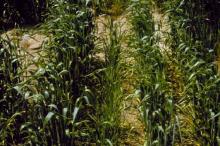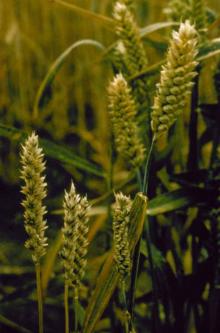See:
Fungicide Effectiveness as Seed Treatments for Cereal Diseases
Cause Two fungi, Tilletia tritici (syn. = T. caries) and T. laevis (syn. = T. foetida), which are carried on seed or in soil and also can infect rye, triticale, and many grasses. Only very young seedlings can be infected. Disease requires cool, moist soil conditions at planting. Infection is either from smut spores on seed (seedborne) or from spores in soil close to the seed (soilborne). Soilborne spores last decades in soil. The disease is a problem in all wheat-producing areas east of the Cascade Range.
Symptoms No positive symptoms are apparent until the crop heads. In infected heads, light brown smut balls filled with dark brown spore masses replace all or part of the kernels. Crushing a smut ball releases a distinctive foul odor. Bunted heads remain green longer, and plants may be slightly stunted, and glumes can be distorted.
Cultural control
- Use pathogen-free seed.
- Resistant varieties are available, but many new releases are susceptible.
Chemical control To prevent developing new races, clean and chemically treat all seed wheat.
- Apron alone and products with imazalil are ineffective.
- Captan, Manzate, Thiram, and Vitavax are registered but used alone give only fair control of seedborne common bunt. All are ineffective against soilborne common bunt.
- Charter (Group 3) at 3.1 fl oz/100 lb seed plus a dye. See label for rotation and reentry restrictions.
- Dividend Extreme (Group 3 + 4) at 2 to 4 fl oz/100 lb of winter wheat, spring wheat, or triticale seed. See label for reentry restrictions.
- Dividend XL RTA (Group 3 + 4) at 2.5 to 10 fl oz/100 lb of wheat seed. Do not graze green forage until 55 days after planting. See label for reentry restrictions.
- Dynasty (Group 11) at 0.153 to 0.382 fl oz/100 lb seed plus a dye. 4-hr reentry.



